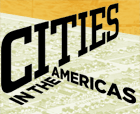Part II: Settlement, Expansion, and the Business
of City Views
Middle Atlantic and Northeastern Cities
35
East View of Baltimore Maryland
T. Cartwright (British, active early 19th century), after George Beck (American,
b. England, 1748 or 1750–1812)
Colored etching and aquatint, published by Atkins & Nightingale, 1802
Deák 220
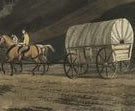 During
the first half of the 19th century, many of America’s most prominent
artists emigrated from England, bringing with them the picturesque landscape
tradition. English landscape painter George Beck came to the United States
in 1795, and traveled throughout the country in search of appealing vistas
such as this one. Cartwright sensitively translated Beck’s drawing,
which highlights the lush foliage and rolling hills of the burgeoning
area
near the Chesapeake Bay, into aquatint. The London publishers Atkins & Nightingale
issued a series of views based on Beck’s drawings (two others, of
Washington, D.C., and Philadelphia, are also on view here, number
14 and
number 22).
During
the first half of the 19th century, many of America’s most prominent
artists emigrated from England, bringing with them the picturesque landscape
tradition. English landscape painter George Beck came to the United States
in 1795, and traveled throughout the country in search of appealing vistas
such as this one. Cartwright sensitively translated Beck’s drawing,
which highlights the lush foliage and rolling hills of the burgeoning
area
near the Chesapeake Bay, into aquatint. The London publishers Atkins & Nightingale
issued a series of views based on Beck’s drawings (two others, of
Washington, D.C., and Philadelphia, are also on view here, number
14 and
number 22).
Lamenting the relentless drive of industrialization, Stokes prized early
views of cities and wondered: “Where can we find to-day such attractive
cities, such alluring villages, and such charming rural and river scenes,
as are portrayed in many of these early views?”
36
View of Utica from the Hotel
Anne-Marguérite-Henriette Rouillé de Marigny, Baroness Hyde
de Neuville (French, ca. 1749–1849)
Pen and ink and watercolor, 1807
Deák 254
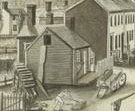 In
1807, the Baron and Baroness Hyde de Neuville arrived in New York after being
banished from France under accusations of conspiracy against Napoleon. Upon
the restoration of King Louis XVIII in 1814, they returned to France and the
baron served as minister to the United States from 1816 to 1822. During their
many travels, the baroness made numerous watercolor sketches, including over
200 of various towns and cities.
In
1807, the Baron and Baroness Hyde de Neuville arrived in New York after being
banished from France under accusations of conspiracy against Napoleon. Upon
the restoration of King Louis XVIII in 1814, they returned to France and the
baron served as minister to the United States from 1816 to 1822. During their
many travels, the baroness made numerous watercolor sketches, including over
200 of various towns and cities.
Soon after their arrival in New York, the baron and baroness were advised
to travel the state before deciding where to settle, and they headed off toward
Niagara Falls. On the way they stopped in Utica, which the baroness captured
in her characteristic unpretentious and straightforward style.
37
Bethlehem
Cephas Grier Childs (American, 1793–1871), after George Lehman (American,
d. 1870)
Colored lithograph, published by Cephas Grier Childs and R. H. Hobson, 1830
Deák 373
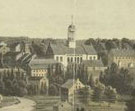 The
Moravian Church, a Protestant denomination based on a revival of a 15th-century
Bohemian sect, was founded in Germany in the 1720s. The first Moravians came
to the Americas in the early 1730s, as part of a missionary movement to convert
the Native Americans. In 1741, they established themselves on the northern
bank of the Lehigh River and, on Christmas Eve, named their settlement Bethlehem.
Their sense of community and shared industriousness attracted a great many
admirers, including George Washington and Benjamin Franklin.
The
Moravian Church, a Protestant denomination based on a revival of a 15th-century
Bohemian sect, was founded in Germany in the 1720s. The first Moravians came
to the Americas in the early 1730s, as part of a missionary movement to convert
the Native Americans. In 1741, they established themselves on the northern
bank of the Lehigh River and, on Christmas Eve, named their settlement Bethlehem.
Their sense of community and shared industriousness attracted a great many
admirers, including George Washington and Benjamin Franklin.
Two Pennsylvania artists created this view: George Lehman, a local landscape
artist raised in Lancaster County, and Cephas Grier Childs, a printmaker born
in nearby Bucks County. Childs started his career by engraving and publishing
views of Philadelphia and became interested in lithography around the time
of this view. In 1831, while traveling in Europe to learn more about this
technique, he had an accident that ended his engraving career. He then switched
to publishing lithographs, becoming a prominent American lithographic printer
and publisher.
38
View of Reading, Pennsylvania, from the Neversink in the Neighborhood
of the White Cottage
A. Zeno Schindler (American, b. Germany, 19th century)
Watercolor and gouache, ca. 1834
Deák 434
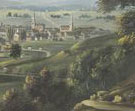 Reading,
which is named after William Penn’s birthplace in England, was founded
in 1748 by Penn’s sons, Thomas and Richard. About 60 miles northwest
of Philadelphia, it is situated in the Allegheny Mountains along the Schuylkill
River. The pastoral charm of the setting was readily captured in this painting
by German-born artist A. Zeno Schindler. Schindler was active in Philadelphia
as a drawing instructor during this period, and later specialized in scenes
of Native Americans. A lithograph based on this view was issued in 1839.
Reading,
which is named after William Penn’s birthplace in England, was founded
in 1748 by Penn’s sons, Thomas and Richard. About 60 miles northwest
of Philadelphia, it is situated in the Allegheny Mountains along the Schuylkill
River. The pastoral charm of the setting was readily captured in this painting
by German-born artist A. Zeno Schindler. Schindler was active in Philadelphia
as a drawing instructor during this period, and later specialized in scenes
of Native Americans. A lithograph based on this view was issued in 1839.
39
Newark, (East of Mulberry St. 1820–5)
Ferdinand Mayer (New York lithographic firm, 1854–77)
Colored lithograph, ca. 1854–77
Deák 325
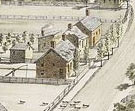 Unsatisfied
with life in Connecticut, in 1666 a group of English Puritans settled along
the Passaic River. Originally called Milford, the city was later renamed Newark
in honor of the Puritan pastor’s hometown in England. The College of
New Jersey, the future Princeton University, was located here from 1747 to
1756, before moving to its current home.
Unsatisfied
with life in Connecticut, in 1666 a group of English Puritans settled along
the Passaic River. Originally called Milford, the city was later renamed Newark
in honor of the Puritan pastor’s hometown in England. The College of
New Jersey, the future Princeton University, was located here from 1747 to
1756, before moving to its current home.
Although this view depicts the city in 1820–25, it could not have been
issued until the second half of the 19th century, when such large aerial views
became popular. The production of these views was phenomenal; of the several
thousand city views produced between 1850 and 1900, the vast majority were
bird’s-eye-view lithographs. At least 2,400 cities and towns were represented.
40
East View of Ithaca, Tompkins County, N.Y.
Henry Walton (American, 1804–1865), after his own design
Lithograph, printed by Bufford’s Lithography (New York and Boston lithographic
firm, 1835–71), ca. 1837
Deák 457
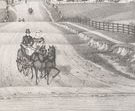 Henry
Walton began his career by sketching scenes of Saratoga Springs, before moving
to Ithaca in 1836. Along with this eastern view of the city, he created two
companion views taken from the west and south. The charming, yet stiff, figures
and lively sense of pattern are combined with precise topography and accurate
architectural representations. Walton remained in upstate New York until 1851,
when he headed west with a group of gold-seekers.
Henry
Walton began his career by sketching scenes of Saratoga Springs, before moving
to Ithaca in 1836. Along with this eastern view of the city, he created two
companion views taken from the west and south. The charming, yet stiff, figures
and lively sense of pattern are combined with precise topography and accurate
architectural representations. Walton remained in upstate New York until 1851,
when he headed west with a group of gold-seekers.
In what became common practice, Walton first exhibited his drawing of the
scene to solicit subscribers, as announced in the local newspaper: “The
view is most graphick, superbly painted, and is to be lithographed in the
best manner, colored to correspond with the original, and furnished to subscribers
for $1.50 per copy…. As no copies are to be published, except for subscribers,
we would recommend for those who wish to procure a copy, to enter their names
without delay.”
41
The Upper Falls of the Genesee at Rochester N.Y. from the East
Bufford’s Lithography (New York and Boston lithographic firm, 1835–71),
after John T. Young (American, ca. 1814–1842)
Colored lithograph, published by C. & M. Morse, ca. 1836–37
Deák 447
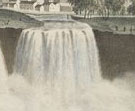 Along
with others who went on to productive careers in lithography, John Henry Bufford
started at the influential Boston lithographic firm of William S. Pendleton.
He later worked under two other prominent printers in New York, George Endicott
and Nathaniel Currier. In 1835, he opened his own firm in Boston, assuming
variously the roles of artist, printer, and publisher. The firm produced an
enormous number of prints and remained in operation, under various names,
until the 1890s. In the 1850s, the renowned painter-illustrator Winslow Homer
got his start there as an apprentice.
Along
with others who went on to productive careers in lithography, John Henry Bufford
started at the influential Boston lithographic firm of William S. Pendleton.
He later worked under two other prominent printers in New York, George Endicott
and Nathaniel Currier. In 1835, he opened his own firm in Boston, assuming
variously the roles of artist, printer, and publisher. The firm produced an
enormous number of prints and remained in operation, under various names,
until the 1890s. In the 1850s, the renowned painter-illustrator Winslow Homer
got his start there as an apprentice.
Although America lacked the historic architecture of Europe, it abounded
in natural wonders, and waterfalls were an extremely popular subject for prints.
Note to the checklist. “Deák” refers
to the catalogue of American historical prints in the New York Public Library’s
collections: Deák, Gloria Gilda. Picturing America 1497-1899. Prints,
Maps, and Drawings bearing on the New World Discoveries and on the Development
of the Territory that is now the United States. 2 vols. Princeton: Princeton
University Press, 1988.
Next Section
